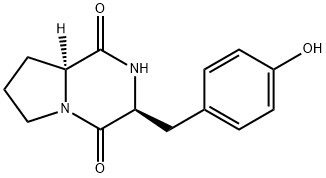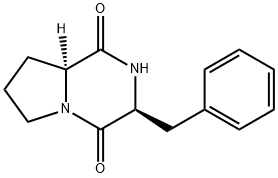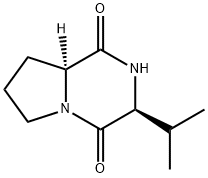MACULOSIN
- CAS NO.:4549-02-4
- Empirical Formula: C14H16N2O3
- Molecular Weight: 260.29
- MDL number: MFCD03093467
- SAFETY DATA SHEET (SDS)
- Update Date: 2024-11-19 23:02:33

What is MACULOSIN?
Description
Maculosin is a diketopiperazine metabolite produced by A. alternata, L. capsici, Streptomyces, and the Gram-negative, nonobligate predator bacterial strain 679-2. It acts as a host-specific phytotoxin, inducing formation of weeping necrotic lesions in leaves of spotted knapweed (C. maculosa) when used at a concentration of 10 μM. Maculosin reduces the growth of the plant pathogenic bacteria X. axonopodis and R. solanacearum (MICs = 31.25 μg/ml) as well as the pathogenic oomycetes P. cactorum, P. capsici, P. cinnamomi, P. infestans, and P. ultimum when used at concentrations ranging from 10 to 100 mg/ml. Maculosin also inhibits the growth of M. luteus, M. smegmatis, S. cerevisiae, C. albicans, C. neoformans, and A. niger when used in combination with pyrrolnitrin or banegasin.
The Uses of MACULOSIN
Cyclo(L-Pro-L-Tyr) (maculosin) is a diketopiperazine formed by the fusion of tyrosine and proline, reported as a secondary metabolite of fungi and bacteria. In Pseudomonas aeruginosa, cyclo(L-Pro-L-Tyr) is capable of activating N-acylhomoserine lactones (AHLs). Cyclo(L-Pro-L-Tyr) is also capable of activating or antagonizing other LuxR-based quorum-sensing systems. While the mode of action of cyclo(L-Pro-L-Tyr) is not known, its activity suggests the existence of cross talk among bacterial signalling systems. Cyclo(L-Pro-L-Tyr) was identified as a host-specific toxin produced by Alternaria alternata on spotted knapweed.
The Uses of MACULOSIN
Cyclo(L-prolinyl-L-tyrosine) is a diketopiperazine derivative isolated from Bacillus thuringiensis and Bacillus endophyticus.
What are the applications of Application
Maculosin is a secondary metabolite of fungi and bacteria
Definition
ChEBI: A homodetic cyclic peptide that is a dipeptide composed of L-proline and L-tyrosine joined by peptide linkages.
Properties of MACULOSIN
| Melting point: | 156-159 °C |
| Boiling point: | 581.4±43.0 °C(Predicted) |
| Density | 1.36±0.1 g/cm3(Predicted) |
| storage temp. | -15°C
|
| solubility | DMF: soluble; DMSO: soluble; Ethanol: soluble; Methanol: soluble |
| form | A solid |
| pka | 9.92±0.15(Predicted) |
| color | White to off-white |
Safety information for MACULOSIN
Computed Descriptors for MACULOSIN
New Products
(S)-3-Aminobutanenitrile hydrochloride 4-Methylphenylacetic acid N-Boc-D-alaninol N-BOC-D/L-ALANINOL Tert-butyl bis(2-chloroethyl)carbamate 3-Morpholino-1-(4-nitrophenyl)-5,6-dihydropyridin- 2(1H)-one Furan-2,5-Dicarboxylic Acid Tropic acid 1-Bromo-3,5-Di-Tert-Butylbenzene S-2-CHLORO PROPIONIC ACID ETHYL ISOCYANOACETATE 2-Bromo-1,3-Bis(Dimethylamino)Trimethinium Hexafluorophosphate 4-IODO BENZOIC ACID 3-NITRO-2-METHYL ANILINE 1-(2,4-DICHLOROPHENYL) ETHANAMINE (2-Hydroxyphenyl)acetonitrile 4-Bromopyrazole 2-(Cyanocyclohexyl)acetic acid 4-methoxy-3,5-dinitropyridine 1-(4-(aminomethyl)benzyl)urea hydrochloride 2-aminopropyl benzoate hydrochloride diethyl 2-(2-((tertbutoxycarbonyl)amino) ethyl)malonate tert-butyl 4- (ureidomethyl)benzylcarbamate Ethyl-2-chloro((4-methoxyphenyl)hydrazono)acetateRelated products of tetrahydrofuran

![1-[[4-[(4-Fluoro-2-methyl-1H-indol-5-yl)oxy]-5-methylpyrrolo[2,1-f][1,2,4]triazin-6-yl]oxy]-2-propanol](https://img.chemicalbook.in/CAS/GIF/649735-46-6.gif)






You may like
-
 2033-24-1 98%View Details
2033-24-1 98%View Details
2033-24-1 -
 42831-50-5 5-METHYLISOXAZOLE-4-CARBOXYLIC ACID 98%View Details
42831-50-5 5-METHYLISOXAZOLE-4-CARBOXYLIC ACID 98%View Details
42831-50-5 -
 1975-50-4 98%View Details
1975-50-4 98%View Details
1975-50-4 -
 2-HYDROXY BENZYL ALCOHOL 98%View Details
2-HYDROXY BENZYL ALCOHOL 98%View Details
90-01-7 -
 2-Chloro-1,3-Bis(Dimethylamino)Trimethinium Hexafluorophosphate 221615-75-4 98%View Details
2-Chloro-1,3-Bis(Dimethylamino)Trimethinium Hexafluorophosphate 221615-75-4 98%View Details
221615-75-4 -
 61397-56-6 CIS BROMO BENZOATE 98%View Details
61397-56-6 CIS BROMO BENZOATE 98%View Details
61397-56-6 -
 14714-50-2 (2-Hydroxyphenyl)acetonitrile 98+View Details
14714-50-2 (2-Hydroxyphenyl)acetonitrile 98+View Details
14714-50-2 -
 118753-70-1 98+View Details
118753-70-1 98+View Details
118753-70-1